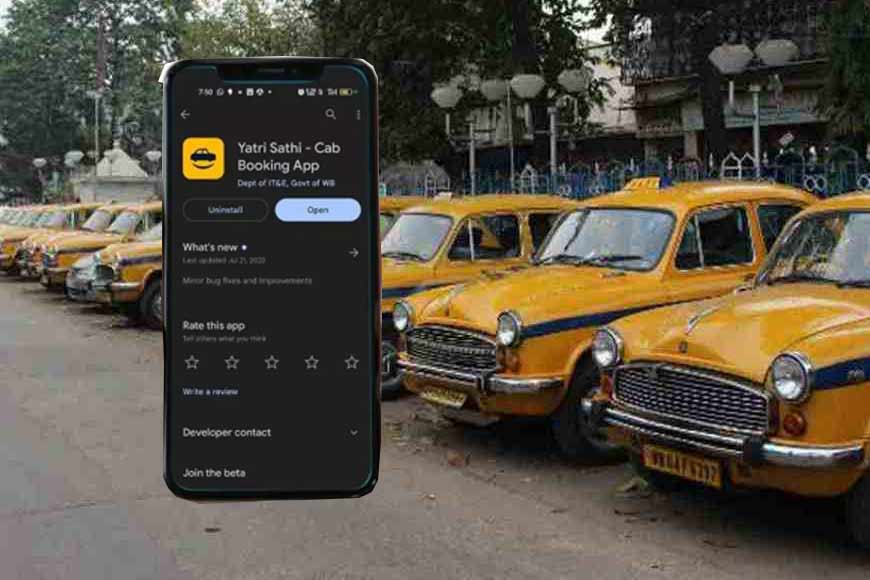State to launch "Yatri Sathi" to revitalize city’s iconic yellow taxis - GetBengal story

Kolkata’s celebrated identifiers include, among other things, the legendary yellow taxis that have been a staple of our streets since they were introduced in 1958. The legacy of those tough yellow mean machines lives on, albeit fighting a losing battle, among the people who grew up in this city before the era of app-cabs. However, the scenario is going to change soon for the better and the fate of the yellow taxis may soon witness a revival of the golden days of the last century. If everything goes according to plan, chances are that Kolkata's nostalgia, the yellow taxi, will run on a mobile app, which will be commercially available from the end of August this year. Passengers will be able to book yellow taxis with one click of a smart mobile phone in the same manner as they avail of cab aggregator services like Ola and Uber.
These days instead of taking the hassle of getting a yellow taxi after several refusals, generation Z is more comfortable with the app cabs that are readily available just a few swipes away on their smartphones and can be booked from the comfort of their homes or workplace. Besides, there has been a long-standing complaint about a large number of unscrupulous yellow cab drivers who harass passengers with very high fares, way above the metered amount, or drop them midway, flatly refusing to reach their destination. The new mobile application, developed under the state government, is named "Yatri Sathi".
Officials of the state transport department are upbeat about this initiative and are optimistic about getting a positive response from prospective passengers. Initially, yellow taxis will be brought under government apps. The Department of Information Technology and Electronics, Government of West Bengal recently approved the Society for Natural Language Technology Research to ease the language processing activities and make the computing activities in Bangla compatible. In major railway stations like Howrah, Kolkata and Sealdah as well as airport yellow taxi stands; drivers are downloading this cab application on their mobiles with the help of the local police. Vehicle numbers and mobile phone numbers are being collected for drivers who do not have smartphones so that they too, can be included under the app in the future.
For generations of Kolkatans, the yellow taxi was a symbol of a quick, hassle-free, dependable mode of transport. However, in 1991, when the Government of India passed reforms allowing operations by private players in the economy, global companies started flooding the Indian market. Besides, by then, Indian consumers had higher incomes and greater spending power to buy a personal car. This reduced public dependence on taxis and made the car industry highly competitive with the entry of foreign brands. The indigenous companies suffered huge losses and were compelled to phase out production.
Taxis first appeared on the streets of Calcutta as early as 1907. From the lanes of Chowringhee, the metered taxi could reach Dumdum, Barrackpore and faraway Budge Budge. The fare was eight annas per mile. A small red 'chariot' with two cylinders, the taxi could only fit two passengers. After Independence, as a major landmark in India’s journey to self-reliance, Brij Mohan Birla (B.M. Birla) set up Hindustan Motors (HM) factory in 1948 at Uttarpara in Hooghly district. The first car to roll out from the Uttarpara plant was the Hindustan 10, based on the Morris 10. In 1957, the Hindustan Ambassador, based on the Morris Oxford series III, was launched. It became immensely popular for its classic design and spacious interior. In 1962, the Calcutta Taxi Association took the initiative to convert the Hindustan Ambassador to a taxi.
Initially, these taxis were available in two variants - black and yellow. While the black taxis commuted within the city’s boundaries, the yellow ones were used for inter-city travel. Over the years though, the black taxis started reducing in numbers, and eventually, only the yellow taxis survived. Since taxis had to be visible from a distance, the colour yellow was chosen, as it is easiest to spot, even at night. The introduction of yellow taxis opened up new job opportunities for people from neighbouring states. Taxi driving became a lucrative occupation and Sikhs and people from Bihar were the majority among the people who thronged the city and joined in the workforce. There was a time when yellow taxis were synonymous with Sikh drivers and Kolkatans were not only fond of the turban-draped taxi drivers but also felt they were in safe hands when they hired a taxi driven by a Punjabi.
The state government plans to rein in the autocracy of the app cabs that operate in the market along with the yellow taxis and book the erring companies for their unscrupulous business tactics. For passengers, lack of available cabs, ride cancellations, and price surges make ride-hailing services increasingly difficult to use. With the introduction of Yatri Sathi, the state transport department is optimistic about checking these unethical practices and streamlining the entire process. It also promises a new lease of life for the city’s iconic yellow taxi.











